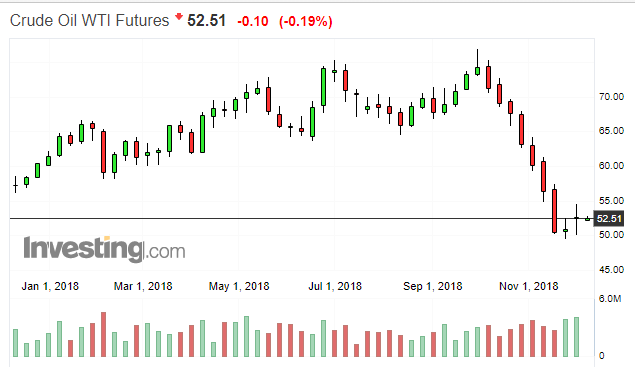Saudi Arabia may have called the United States’ bluff in announcing an oil production cut, but in putting out one fire, Saudi Energy Minister Khalid al-Falih has possibly started another: the potential for even more U.S. oil drilling if prices rally.
The clause “if” is important because although the market settled up on Friday, it only held 2 percent of the original 5 percent gain it made during the day on news that the Saudi-led Organization of the Petroleum Exporting Countries (OPEC), as well as its allies, including Russia, will cut a total of 1.2 million barrels per day of crude supply over the next six months.
By Monday, the rally looked like it had topped, with US West Texas Intermediate (WTI) crude down at around $52 per barrel in early Asian trade, versus the 13-month bottom of $49.41 struck at end-November. While global benchmark Brent was up, hovering at $62 per barrel, it struggled to gain beyond 0.5 percent.

Will The Cuts Be Enough?
Dominick Chirichella, a veteran OPEC watcher for nearly 40 years, said with the anticipated production cuts already known, “the discussion is now moving to… is it enough, will all participants comply to the agreement, how long will it take for global inventories to return to the five-year average and what will be the implications on prices?”
The director of Risk And Trading at the Energy Management Institute in New York described all these as “very typical questions that will be asked and answered many times over in the coming months as the projected period moves into the actual/historical period.” Analysts say the production cuts will take place during a period projected to be weak for energy demand anyway, due to an economic slowdown expected in China and other major centers of the world.
Of particular attention to the market this week will be the US Energy Information Administration’s Short Term Energy Outlook (STEO) due on Tuesday. Released each quarter, the report is followed closely by the market and is expected to garner even more interest this time given the implications of OPEC’s production cuts, as well as that of Canada – the largest crude supplier to the US, which is reducing 9 percent of its own supply due to weak oil prices.
Chirichella said he agreed with many analysts that if supply fell short of demand by the end of the first quarter of 2019, then global inventories could move into a steady destocking pattern. But he promptly added that this is “based on an optimistic global demand profile”.
US Oil Drillers Could Unleash New Tsunami Of Supply
Taken another way, it underscores the market’s pessimism about the long-term impact of the cuts announced on Friday: While they may be enough to put a floor under a market that’s lost 35 percent of its value in two months, they are unlikely to be deep enough to contain the tsunami of supply that US oil drillers could unleash within the next six to 12 months – particularly if crude prices get any better.
John Kilduff, partner at New York energy hedged fund Again Capital, said: “It’s highly likely the market will do better with these cuts, though how much better is the question. We added 2 million barrels in the US over the last one year with a 30 percent price gain. So, logically, a 15 percent price gain could bring in another million barrels or more, enough to negate these cuts.”
Kilduff added: “I’ll bet that nearly every shale driller in the US has secured enough hedges in the $60 to $70 area to keep them going a year forward. And drilling-price efficiencies in shale get better according to the region, where in the Permian you can be profitable at even $40 a barrel versus the mid to high $50s you need in the Bakken. WTI at $55 to $60 over the next six months will be good for many US drillers.”
The United States is already the world’s largest oil producer, churning out 11.7 million bpd, according to latest data, versus the 11.1 million bpd pumped by Saudi Arabia and 11.4 million bpd by Russia. Last week, the American energy sector earned another new distinction: For the first time in 75 years, the country became a net oil exporter, shipping more crude and oil products combined than it imported.
In another development, the U.S. Department of the Interior announced at the end of November shale formations in the Delaware Basin portion of Texas and New Mexico’s Permian Basin contain an estimated 46.3 billion barrels of oil, 281 trillion cubic feet of natural gas, and 20 billion barrels of natural gas liquids, making them the largest continuous oil and gas resource potential ever.
Trump Response May Come Another Way
Politically, President Donald Trump had not fired back at the Saudis and other OPEC members for the production cuts announced on Friday, compared to the storm he unleashed on Twitter earlier, telling the combined group to keep its oil flowing freely and possibly at even cheaper prices.
For weeks, there had been speculation the Saudis might do as he suggested as Trump had been protecting Riyadh from the threat of U.S. sanctions after the murder of Saudi-born but US-residing journalist Jamal Khashoggi, whom the CIA believes was killed at the urging of Saudi Crown Prince Mohammed bin Salman.
Still, the president could have done more long-term damage to the interest of non-US oil producers with another act of his last week. Just as the OPEC meeting got underway on Thursday, Trump opened up nine million acres in the Western US for drilling. These are lands said to contain some of the richest oil deposits but kept off limits to oil drillers until now as sanctuary for the protection of the sage grouse bird.
